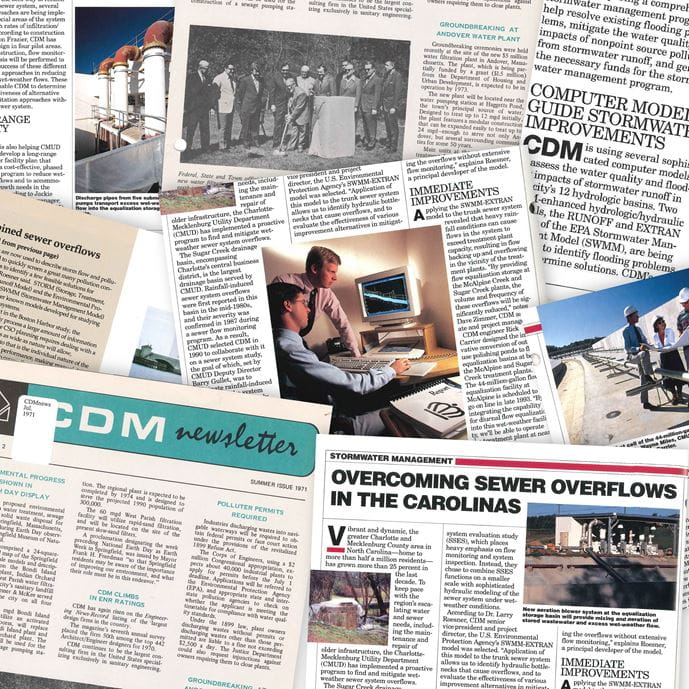A Look in the Sewer: Using Wastewater-Based Epidemiology to Track COVID-19
Wastewater-based epidemiology (WBE) is a disease-tracking tool that involves analyzing untreated wastewater for biomarkers. This public health tool serves as an early warning system and provides a timely and cost-effective way to assess the health of communities. A recent article from Yale University showed the SARS-CoV-2 viral signal in wastewater may indicate trends in disease incidence in the contributing sewer service area 7 days before clinical testing of the population.
The SARS-CoV-2 virus that causes COVID 19 is excreted by the body and carried through wastewater to the local sewage treatment plant. Although the SARS-CoV-2 virus is very dilute in wastewater, researchers are still able to detect and measure the viral signal through RNA markers. Researchers are employing qPCR technology commonly used in labs and hospital settings to clinically diagnose individuals to prove that the small quantities of the virus RNA present in untreated sewage can be measured in the complex matrix of wastewater. The data collected can be used to track warnings of potential recurrences of diseases like COVID-19 without testing residents individually.
Even after the COVID-19 crisis subsides, long-term monitoring of wastewater can provide ongoing benefits to communities and decision makers. WBE techniques have been successfully applied to investigate the occurrence of diseases like norovirus, polio and hepatitis A. They have also been used to investigate patterns in other public health characteristics, such as opioid usage and even stress levels in the population.
Teaming up with Dr. Xagoraraki at MSU
Irene Xagoraraki, Ph.D., associate professor of civil and environmental engineering at Michigan State University (MSU), is a pioneer in the field of WBE, and has quickly moved to apply her research to SARS-CoV-2 to mitigate the societal impacts of COVID-19. Dr. Xagoraraki’s own research prior to the current COVID-19 crisis demonstrated that extremely low trends of hepatitis A in the population could be discerned in wastewater.
In March, Dr. Xagoraraki’s team at MSU teamed up with CDM Smith and the Great Lakes Water Authority (GLWA) in Detroit with the goal of rapidly developing a practical method for applying WBE at the community scale. The aim of our research is to provide advanced notice of future trends in COVID-19 disease in the population as a whole, which can help Detroit’s decision makers take targeted action in the event of a resurgence of the disease.
Since March, more than 100 samples have been collected from Detroit’s wastewater flows at three interceptors—downstream endpoints of separate sewer collection networks in the city—and successfully analyzed in Dr. Xagoraraki’s laboratory using the sensitive virus quantification method she has developed. Our research team will be working with Dr. Xagoraraki to correlate the virus signal with the number of COVID-19 cases within the contributing sewer service area.
Our goal is to generate a public health tool that will inform short-term responses to viral threats, long-term disease prevention and be applicable to other viral diseases beyond COVID-19.
Findings in Detroit
Although we are still in the early stages, the findings are promising. The methods team has optimized sample collection and testing methods and has produced repeatable results in Detroit. John Norton, Jr., Ph.D., PE, director of energy, research and innovation and Xavi Fonoll, PhD, research and innovation management professional at GLWA have led the efforts to capture and analyze weekly samples using Dr. Xagoraraki’s method.
“We are proud to financially and technically support this project,” says Dr. Norton. “This project has significant implications for providing a near real-time signal of disease incidence in the community. In addition, this project strongly aligns with our core mission of providing excellent water and wastewater services to the public.”
Since Dr. Xagoraraki’s method is still newly applied to the SARS-CoV-2 virus, samples are being thoroughly checked for quality. Once the results are released, CDM Smith researchers will work with Dr. Xagoraraki to develop the predictive model that correlates the viral signal observed in GLWA's wastewater with clinical information available for COVID-19 disease. After the viral predictive model has been developed for Detroit, the goal is to move sample collection up into the sewer system, to provide the city’s decision makers with more granular information at the neighborhood scale.
Additional Applications
WBE can also provide key insights into the collective health of residential communities at the facility scale. Our hypothesis is that WBE concepts can be effectively applied to military bases, university campuses, large industrial facilities, residential healthcare facilities – even cruise ships and prisons. Understanding the urgency to quickly develop practical solutions, CDM Smith is engaged in pilot testing research of a simpler, inexpensive and readily available testing methods with a rapid turn-around time. A facility-scale approach could be used in WBE applications to highlight the benefits of wastewater monitoring programs to public health at the facility scale or neighborhood scale. At this scale, early detection of the onset of viral infection in the community can be used to quickly implement measures to care for residents and protect workers, and it may be less necessary to employ more sensitive (and expensive) methods of analysis to capture subtle trends.
With advanced warning provided by WBE, decision makers at the facility scale can employ enhanced personal protective equipment protocols and more frequent or targeted clinical testing to identify and isolate affected individuals. Additionally, as the science of WBE matures to provide near real-time information, it can be used to bolster public confidence in water reuse, by reliably identifying changing water quality conditions in community wastewater streams, before the reclaimed water is treated for sensitive reuse purposes like drinking water.


Thanks to our firm's internal R&D program we were able to mobilize quickly to apply our skills and connect with other strategic thinkers to help.







